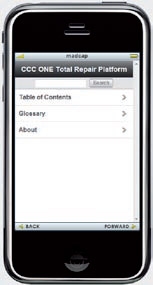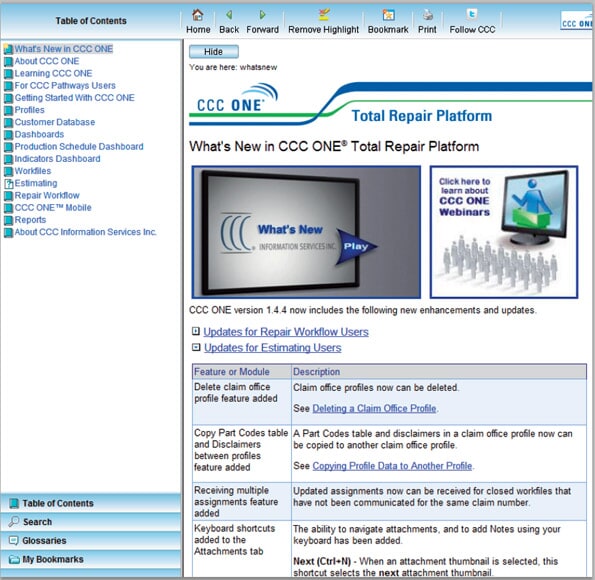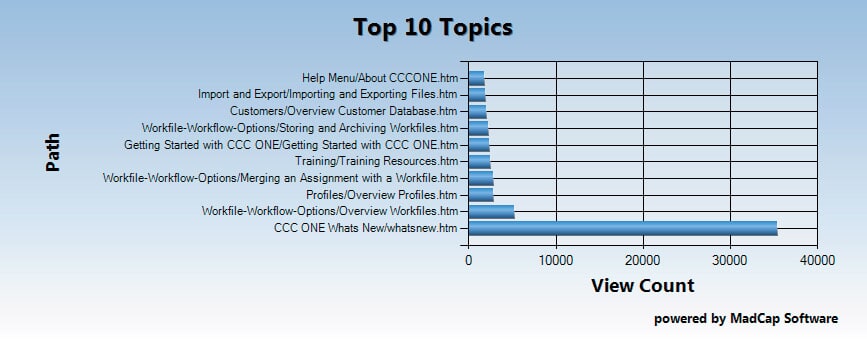Help goes mobile at CCC
Riyaz Adamjee describes how CCC is strengthening support via a holistic, and now mobile, approach to technical communications
At CCC Information Services Inc. (CCC), we provide more than 24,000 businesses with technology solutions for managing automotive insurance claims and auto body collision repairs. So, clear communications are a top priority for us. Consequently, we are continually seeking new ways to deliver highly relevant and accessible online help and documentation to our corporate customers and our sales teams who support them.
Today we are addressing this challenge with a combination of tools from MadCap Software: MadCap Flare for delivering help in print, on the Web and to mobile devices; the MadCap Feedback Service for understanding how we can tune help to support our users’ needs; and MadCap Analyzer for improving the quality of our help.
By taking a holistic approach, we have been able to reduce the demands on our support team while enhancing the user experience. In fact, our support team is seeing anywhere from a 15 percent to 35 percent drop in “how-to” calls, which suggests that customers are finding it easier to follow our help instructions.
Following is an overview of how we are using each of the MadCap tools at CCC to achieve these results.
Mobilising our help
For nearly five years, we have been using the MadCap Flare single-source, multichannel-publishing software to develop and publish our Web-based help systems and print documentation. This has proven very effective for our customers. However, we wanted to make it easier for our sales and account teams to respond to customers’ questions even when they are in the field.

Figure 1. Mobile Help
We began to look at producing mobile help content and were intrigued by the growing use of Quick Response (QR) codes for mobile access to information and transactions, particularly in Europe and Asia.
It turns out our timing was good. MadCap, which had introduced native mobile output to Flare in 2010, added QR Code generation support in February 2011.
There was no need to rely on additional software. Mobile was simply one more publishing target in addition to the current Web and PDF print targets. We just had to set the condition tags in Flare to identify which topic elements we wanted to publish (or refrain from publishing) in the mobile format.
By March, we had the mobile Help content in place and had sent QR codes to the sales and account teams.
Now when a customer calls, a sales representative in the field or on the road can simply use his or her smartphone to scan the QR code and be automatically linked to the mobile Help system in order to search for the answer. Our sales people have been thrilled by the time savings and the ability to say, “Hold on, let me look that up,” instead of “Let me get back to you.”
Of course, the move to mobile is not a fully automated process. There is some content in the Web-based help that we do not need for the mobile version, so we have to correctly mark the condition tags to prevent them from being published.
Additionally we have learned that not all mobile platforms support all video formats. For instance, some formats that work on a Blackberry or Android device don’t work on an iPhone, and vice versa.
In many cases, we have found that the Adobe Flash videos in our Web-based help are not required on the mobile devices. Our sales and account teams just want to read the answer, and the smartphone screen is too small to be practical for most videos.
In those few instances where we want mobile access to video, notably for short introductions, we have met the need by working with a mix of formats, including QuickTime and Audio Video Interleave (AVI).
In the near term, we will continue to focus on delivering mobile help to our employees, but we are evaluating the potential benefits of extending mobile content to our customers.
Evaluating the user experience
In the last five years, we have grown from providing one Help system to more than a dozen. While we expanded where we publish online help, we have also invested in gaining deeper insights into how effectively they serve our users.
Since 2009, we have been using the hosted MadCap Feedback Service to support this effort. Provided via a software-as-a-service (SaaS) model, it has allowed us to begin using the tool immediately without having to set up the local infrastructure.
Feedback Service, which is tightly integrated with Flare, allows us to analyse how customers are using the Flare-based online help. We can see what people are looking for in the help systems, what search terms they are using, and when those searches are not coming up with results. It also helps us identify if there is a keyword issue or missing topic.
The tight integration between the Feedback Service and Flare means that if, for example, I’m working on a topic within a given help system in Flare, with the click of a button, I can go to the Feedback Service to get trending, reports, and search results that guide me on what to do to update the topic.
It may require updating the keywords to increase the rate that the topic is found in a search, and all I need to do is get back into Flare with a simple click, to adjust it accordingly.
MadCap Feedback Service can also conduct a time analysis to compare the number of people using a help system from one month to the next. It has allowed us to demonstrate a clear increase in the number of people using the help systems.
As a result, we are able to cost-justify purchasing the on-premise MadCap Feedback Server, which offers additional functionality. One is support for analysing mobile help. Another is Feedback Server’s Web 2.0 functionality for letting users rate and add comments to the help content in real time—providing more direct interaction with our customers.
We are currently putting the necessary infrastructure in place and expect to deploy Feedback Server in the near future.
Evaluating the user experience
Most recently, we have rolled out MadCap Analyzer to all of our technical writers. As with the Feedback Service, Analyzer is tightly integrated with Flare.
By running one of our Flare-based help systems through Analyzer, we obtain detailed reports on broken links, orphan topics to which there are no links, images that are not being used, and other areas where the system can be improved.
Because of the tight integration, we can make corrections to any Help topic by opening MadCap Flare directly from within Analyzer.

Figure 2. Webhelp
Initially we had the typical learning curve in using Analyzer. However, since then, it has helped us tremendously in cleaning up our output and the help projects overall. That translates into higher quality documentation and a superior experience for our customers.
Bringing it together
On average, we now publish a dozen updated help systems each month. Together MadCap Flare, MadCap Feedback Service, and MadCap Analyzer are enabling us to create new topics and update existing ones to make our help easy to access and understand.

Figure 3. Feedback Service
As a result, we are continuing to enhance the customer experience while improving the cost-management and efficiency of our sales and support teams. It’s a win for everyone.
About the Author
Riyaz Adamjee
Riyaz Adamjee is Manager of Communications Services at CCC Information Services Inc. He has more than 22 years of experience in the computer-based training and technical communications fields.




